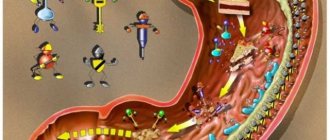How to properly create a daily routine is one of the most important topics in a healthy lifestyle. Every person is faced with the need to manage their time. Sometimes, as in the case of work, it is a necessity. Sometimes, for example, when planning the most productive pastime or vacation, this is expediency.
A proper daily routine involves rational use of sleep time, personal hygiene, nutrition, work, rest, sports and physical activity. Planning a daily routine and following it makes a person disciplined, develops organization and focus. As a result, a lifestyle is developed in which the expenditure of time and energy on non-essential things is minimized.
This lesson will answer questions about the correct daily routine, the peculiarities of the influence of biological rhythms on the activity and efficiency of human activity, the basic approaches and methods for creating a daily routine for different people: men and women of different professions, adults, students and schoolchildren.
What is a daily routine
Let's start with the definition:
Daily routine – a well-thought-out daily routine, planning time with the aim of rational and most effective distribution of it.
As mentioned above, routine is of great importance for self-discipline and organization of any person, and it is also important for many other practical aspects of our lives. For example, the daily routine plays an important role in building training programs, creating diets and organizing proper nutrition in general, and choosing the most productive hours of our life for work or creativity.
Mason Curry, in his book Genius Mode: The Daily Routines of Great Men, gives the following analogy to a daily routine:
“In skillful hands, a daily routine is a precisely calibrated mechanism that allows us to make the best use of our limited resources: first of all, time, which we most lack, as well as willpower, self-discipline, and optimism. An orderly regime is like a track along which mental forces move at a good pace..."
A daily routine is needed so that time does not take advantage of our absent-mindedness (see epigraph). Every person has encountered haste in their activities, a feeling of amorphous time, and confusion in personal and work affairs. We cannot always clearly say how much time we spent on a particular activity, because we do not consider it necessary to constantly monitor the use of our time. However, it is the entire routine of the day that helps you manage your time most wisely and effectively. In addition, without the skill of successfully planning your day, a person will not learn to make longer-term plans, especially since planning your entire daily schedule is not so difficult, because:
| ✔ | The day, as a minimum unit for planning, is most convenient due to its easy visibility. |
| ✔ | If any attempt fails, you can rebuild and change the regime the next day. |
Let us also note the fact that the use of the epithet “correct” in relation to the daily routine is somewhat arbitrary. Individually, for each person, the concept of a correct routine can be different and depend on many factors: work, habits, characteristics of the body. But, according to experts (psychologists and doctors), the physiological aspects of the functioning of the basic life systems of people are identical [Wedemeyer GA, 1996]. Based on this, it is possible to create a universal regime containing general recommendations that will suit everyone to one degree or another. Based on the recommendations offered and taking into account your individual needs, you can develop a daily routine that is optimal for you.
Diet for weight loss
A proper diet for weight loss should be followed by everyone, because it is inherent in us by nature. Meals according to the clock for weight loss are compiled individually. Develop a menu, buy groceries, prepare food for the week ahead. For convenience, keep a notebook or diary to record your daily routine, menu, and training regimen. Recommendations will help you understand how to develop a meal plan for weight loss:
- eat at the same time 6-7 times a day;
- consume complex carbohydrates before lunch and protein after it;
- For the evening, choose fermented milk products.
Biological rhythms and daily routine
Without taking into account the daily biological rhythms of the body, a person is unlikely to be able to create an organized and effective daily routine [Nature, 2009]. For example, if a person who is used to usually waking up at 7 am sleeps until 4 pm one day, after waking up he will most likely feel tired, tired, and slow in activity. This condition occurs as a result of ignoring the peculiarities of biological rhythms, biological clocks and circadian rhythms.
Biological rhythms (biorhythms) are periodically repeating changes in the nature and intensity of biological processes and phenomena in living organisms, on which their functionality depends.
Biorhythms are internal (endogenous), depending on the biological clock of the body, and external (exogenous), which manifest themselves in the synchronization of internal cycles (change of sleep and wakefulness) with external stimuli (change of day and night). In terms of creating a daily routine, we are most interested in circadian rhythms - cyclical fluctuations in the intensity of various biological processes associated with the change of day and night, the period of which is approximately 24 hours [Komsomolskaya Pravda, 2016].
Until recently, many researchers classified the study of biorhythms as a non-academic area of physiology, but thanks to recent research the situation has changed somewhat. Thus, in the human brain, a tiny cluster of approximately 20,000 neurons was discovered in the hypothalamus, which controls many of the body's circadian rhythms. Known as the suprachiasmatic nucleus (SCN), this center acts as the body's internal pacemaker and influences human biorhythms [Moore RY, 2001].
Owls and larks
Psychologists often refer to the well-known division of people, depending on the period of their activity, into “night owls” and “larks”. It is difficult for the first to get up early in the morning, and their peak activity occurs in the evening and night hours. The latter, on the contrary, are active in the morning, and by the evening they quickly lose energy reserves. It is interesting that in many African countries there are practically no “owls”, this is due to the fact that many towns and cities are not electrified, which means that when the sun goes down, local life comes to a standstill.
In addition to “owls” and “larks”, there is also an unofficial transitional option - the so-called “pigeons”, which combine features of both categories: such people can wake up and do things equally actively and effectively at different times of the day. In addition, there are two more types of people: short sleepers and sleepyheads. People who sleep little are active both early in the morning and late in the evening, and to restore strength they need only 3-4 hours of sleep (such people included, for example, the famous inventor T. Edison). “Sleepyheads,” on the contrary, are inactive and feel tired and fatigued at any time of the day.
The proposed classification is rather arbitrary, since, as practice shows, a normal healthy person, if desired, can gradually change his type of wakefulness without harm to the body. The main thing is the presence of willpower and the right strategy.
For example, many politicians, businessmen, and athletes who travel a lot around the world often have to adjust their circadian rhythms in accordance with the time difference between cities in order not to lose efficiency in their work when changing time zones. In practice, special recommendations have even been developed that will help you restructure your routine as painlessly as possible after a time zone change. To do this you should:
| 1 | Plan the first days of arrival so that, if possible, psychological and physical stress is minimal. |
| 2 | Two days before the flight, eat only light food, exclude alcoholic beverages, as well as foods that are unusual for you, and, if possible, refrain from smoking. |
| 3 | Please note that it is better to fly from east to west on a morning or afternoon flight, and from west to east - on an evening flight. |
| 4 | 3-5 days before departure, gradually rearrange your regime in accordance with the time zone of the place where you are going to fly. |
| 5 | If you have a flight to the west, try to go to bed and wake up later. When traveling in an easterly direction, you need to fall asleep earlier and wake up early in the morning. |
Often people do not even have to use their willpower to change their activity mode, since the human body is able to independently adapt to changing external conditions. For example, regular schoolchildren tend to go to class by 8:30 a.m. during long school periods. Over the years, the student’s body gets used to following a given circadian rhythm, that is, working actively in the first half of the day. However, if, after graduating from school, a graduate enters the university in the evening department, where classes are held in the second shift, the body has to adapt to the new schedule. Over time, the student's biological clock naturally adapts to the new system without much effort on his part.
Knowing how your biological clock works will help you plan your day correctly. Below is an approximate calculation of the periods of activity of different systems of the average person by the hour:
04:00.
Beginning of the circadian rhythm. At this time, the body releases the stress hormone cortisol into the blood, which triggers the mechanisms of basic functions and is responsible for our activity. It is this hormone that helps people who prefer to get up early wake up.
05:00-06:00.
Awakening the body. During this period, metabolism accelerates, the level of amino acids and sugar increases, which do not allow a person to sleep soundly in the morning.
07:00-09:00.
The ideal time for light physical activity, when you can quickly tone your body, relaxed after sleep. At this time, the digestive system works well: the absorption of nutrients occurs faster, which helps to efficiently process food and convert it into energy.
09:00-10:00.
The period when the energy received from eating is absorbed. During this time, a person is able to cope well with tasks of attention and intelligence, as well as successfully use short-term memory.
10:00-12:00.
The first peak of performance, the period of maximum mental activity. At this time, a person copes well with tasks that require increased concentration.
12:00-14:00.
A time of deterioration in performance, when it is necessary to give rest to a tired brain. This period is suitable for a lunch break, since the work of the digestive tract accelerates, blood flows to the stomach, and the body’s mental activity decreases.
14:00-16:00.
It is better to devote this time to calmly digesting what you have eaten, since the body is in a state of mild fatigue after lunch.
16:00-18:00.
The second peak of activity and performance. The body has received energy from food, all systems are working in full mode again.
18:00-20:00.
The best time for dinner, the body will have time to digest the food received before the morning. After eating, you can take a walk or an hour later do physical exercises, go to training.
20:00-21:00.
This time is suitable for sports, visiting classes, and socializing.
21:00-22:00.
The period when the brain's ability to remember increases. It is not recommended to eat at this time.
22:00.
Beginning of the sleep phase. Regenerative processes are launched in the body, youth hormones are released. The body goes into a state of rest.
23:00-01:00.
At this time, the metabolic process slows down as much as possible, body temperature and pulse rate decrease. The deep sleep phase begins when our body rests best.
02:00-03:00.
The period when all chemical reactions are slowed down, hormones are practically not produced. Lack of sleep at this time can lead to a deterioration in your condition and mood throughout the day.
Note:
in the cold season, there is a slight shift of the described processes of physiological activity forward in time.
Diet menu by day of the week
Day 1. Breakfast – vegetable or fruit salad (100 g), to which you can add oatmeal and natural unsweetened yogurt, 1 teaspoon of honey; 2 rye bread sandwiches with a transparent layer of butter. Lunch – 60-70 g low-fat cottage cheese, 100 g vegetable salad, seasoned with lemon juice and 1 tsp. flaxseed oil, 2 bread sandwiches with a transparent layer of butter. Afternoon snack – 150 g of low-fat cottage cheese, half a glass of kefir, 1-2 apples. Dinner - pancakes with cabbage, pumpkin or zucchini without baking powder, without sugar; a cup of unsweetened tea or dried fruit compote.
Day 2. Breakfast – natural coffee without sugar, but with 10% cream, buckwheat or rye bread with a transparent layer of butter. Lunch – 2-3 boiled potatoes and a large portion of fresh vegetable salad. Afternoon snack – tea with milk without sugar, 3-5 spoons of jam. Dinner – 300 g of lean beef or chicken meatballs with a side dish of stewed cabbage. Rose hip decoction without sugar.
Day 3. Breakfast – coffee without cream and sugar, 1 rye or buckwheat bread. Lunch – vegetable or mushroom low-fat soup. Afternoon snack – up to 350 g of fresh vegetables, berries or fruits. Dinner – 200 g of boiled green beans (can be replaced with frozen green peas), 200 g of stewed broccoli. Vegetable salad with flaxseed or olive oil and grapefruit or lemon juice.
Day 4. Breakfast - salad of one apple, banana, pear, 1 tablespoon of oatmeal and 100 g of low-fat kefir. Or a vegetable salad of 1 medium-sized cucumber, chopped lettuce, dill and half a glass of kefir, with 1-2 rye bread. Lunch - a salad of cucumbers and herbs, seasoned with a teaspoon of soy sauce and the same amount of lemon juice and vegetable oil, 2 hard-boiled eggs, a glass of tomato juice. The diet by day of the week recommends drinking freshly squeezed juices rather than store-bought ones.
Day 5. Breakfast – rye bread and coffee or tea, without milk or sugar. Lunch – 3 potatoes, baked in the oven with 1 tsp. vegetable oil, sliced fresh vegetables: cucumber, tomatoes, bell pepper. Afternoon snack – 150 g of a mixture of peeled nuts and dried fruits. Dinner – spaghetti, 1-2 fresh tomatoes. But it will be better if the spaghetti is replaced with millet, buckwheat porridge or crumbly boiled rice. Millet porridge can be prepared with pumpkin pieces. The taste of buckwheat porridge will be improved by crushed and fried with 2-3 tsp. vegetable oil onion. Rice can be served with tomato sauce.
Day 6. Breakfast - a cup of green tea without sugar, a salad of 1 green apple and grated raw carrots, 30-50 grams of not too fatty cheese. Lunch – 200 g of boiled liver, or 300 g of beef, or 500 g of boiled turkey (chicken) with a side dish of boiled cauliflower or stewed white cabbage, chopped fresh vegetables, herbs. Afternoon snack – 2 apples ( the diet according to the days of the week allows you to replace them with oranges, pears, peaches, 3 kiwis, pomegranate
). Dinner – 200-250 g of vegetable stew made from eggplant, zucchini, broccoli and tomatoes, 2 rye bread.
Day 7. Breakfast - tea or coffee without sugar, but with 1 tsp. 10 percent cream, 1-2 rye or buckwheat bread. Lunch – boiled potatoes in their jackets (3 pieces) with 1-2 tsp. flaxseed oil, chopped fresh vegetables, herbs. Afternoon snack – a handful of any dried fruits. Dinner - a large portion of fresh vegetable salad, 100 g of cheese, 1 rye bread.
Components of the daily routine
We have already said that it is impossible to offer a universal daily routine that would suit everyone. When creating a schedule, many personal factors are taken into account, but there are also points that everyone must follow. These are necessary conditions for everyone who wants to lead a healthy lifestyle and be healthy.
1
Dream
The realities of the modern world are such that many people either devote insufficient time to sleep or regularly sleep more than is required for the body. In both cases, this negatively affects the physical condition of a person and his activities. A clear daily routine and properly allocated time for sleep allow all human life support systems to recover and rest, and also help to avoid sleep and nervous system disorders [MedicalNewsToday, 2021, Ho L., 2020].
So, the ideal time for sleep is considered to be from 11:00 pm to 7:00 am [Healthline, 2019]. On average, an adult should sleep about 7-8 hours a day, although there are many cases where people slept much less (3-6 hours a day), but felt great and did their job effectively. Famous successful short sleepers include Julius Caesar, Leonardo da Vinci, Benjamin Franklin, Napoleon Bonaparte, Thomas Jefferson, Salvador Dali, Nikola Tesla, Thomas Edison, Winston Churchill and Margaret Thatcher.
However, you should not resort to extreme cases and neglect healthy sleep altogether. In some clinical experiments, isolated cases were observed in which people did not sleep for more than 250 hours in a row. By the end of this period of time, doctors noted attention disorder in patients, the inability to focus vision on an object for more than 20 seconds, and psychomotor impairment. Such experiments did not bring much harm to health, but they knocked the human body out of its usual state for several days.
For many people who want to align their schedule and learn to go to bed early, the question of “how to fall asleep” at the planned time is relevant. Here are some recommendations:
- Instead of watching detective series on TV or surfing the Internet before bed, it is better to read a book.
- A few hours before bedtime, you should exercise, run, or just walk.
- You should not eat heavy food at night.
- It is useful to ventilate the room before going to bed.
- Thus, create your daily routine so that when you go to bed, your body feels tired.
Even if you can’t fall asleep in the evening for a long time, you still need to get up in the morning at the planned time. You may not get enough sleep one day, but the next night you will be able to fall asleep earlier.
2
Meals
Everyone knows the phrase “you need to eat to live,” but you need to eat right. We will talk in detail about proper nutrition and everything connected with it in the next lesson; here we will note only a few important nuances. Food is fuel for the body. With it, we not only receive energy for the day, which is spent on mental and physical activity, but also provide the body with the necessary vitamins and microelements. That is why it is important to eat regularly and nutritiously; the need to use a diet must be agreed upon with a specialist who will help create the optimal menu taking into account the physiological needs of the body.
3
Rest
Restoration of strength and performance of the body occurs not only during sleep, but also during the period of activity of the body. During work, a person also needs rest, since it is impossible to constantly maintain work capacity at a high level. Don't waste your lunch break doing work, get some rest, and soon you'll be able to get down to business with renewed vigor and be more productive and efficient.
It is also important to rest after work. If you work on the computer all day, when you return home, spend the evening without it. Take time to read, communicate with family and friends, and educate yourself.
4
Job
Each of us has to work: schoolchildren - go to classes and do homework, students - attend lectures and seminars, prepare for exams, adults - build a career and earn a living. The ability to plan your working time is an important part of your daily routine as a whole. Methods of self-management, time management, as well as recommendations for increasing personal effectiveness at work and outside of it can be found in the articles in the special section of our blog “Time-management and efficiency”.
5
Physical exercise
This is a recommended part of the day for everyone who cares about their health. Those whose work limits the physical activity of the body throughout the day should think about training first of all. Even if you don’t have the opportunity to join a gym or go to the pool, you can exercise at home or on playgrounds in courtyards and schools. If there are medical contraindications, instead of playing sports, you can practice light walks in the fresh air after meals. Read more about the role of physical activity in a healthy lifestyle in this lesson.
6
Mental balance
As they say, “a healthy mind in a healthy body,” but the opposite is also true. If a person is calm and satisfied with life, and enjoys his work, it means that it is easier for him to maintain a daily routine. To understand yourself, we have created a special course “Self-Knowledge”, which will allow you to understand yourself, understand your strengths and weaknesses. Find out more.
How to plan your daily routine
Benjamin Franklin’s daily schedule looked like , which he posted in his “Autobiography”:
(image based on a fragment of the book by M. Curry)
Below are some guidelines for creating your daily routine.
How to create an adult's daily routine
When creating a daily routine, focus on the following points:
| 1 | Try not only to think through the schedule, but also to write it down. Use special programs, a diary, or just write it down on a piece of paper. A written daily routine will not only remind you of things to do, but also serve as a silent reproach if anything planned is not completed. |
| 2 | It is important that at first the routine includes only what you actually do during the day. Simply put, you should include items in your schedule that you are sure to complete, for example, get up at 7 to get ready, have breakfast and, taking into account the travel, be at work by 9. If you just want to go to the gym after work, but have never done it before, you shouldn’t include such an item in your daily plan. Later, when the idea can be implemented, the regime can be adjusted. Remember that you can accustom yourself to following a routine, and, therefore, self-discipline, only by fulfilling the actual points of the schedule. |
| 3 | In different components of your regime (primarily this concerns work), rank the tasks. Place difficult tasks first and complete them in the same order. |
| 4 | Try to take into account the physiological needs of your body, which were mentioned above. Maintain personal hygiene, don’t stay up late, eat meals at the same time. |
| 5 | It is also important that a few days after deciding to start drawing up a regimen, you begin to note the periods of time spent on certain actions. Find an average of how long it takes you to have breakfast, get to work, respond to emails, communicate with colleagues, etc. Based on the data obtained, you need to create the first daily regimen. The use of the “first” characteristic is not accidental - in the future, most likely, you will repeatedly adjust your regime, and it is important to learn during this process to rely on specific time frames, and not on subjective feelings of the time spent. |
Obviously, the daily routine is compiled in accordance with employment at work, which is more or less defined. Nevertheless, it is important to plan not only working time, but also rest, time for household chores and other matters. This is sometimes difficult to do, but over time you will learn.
How to create a daily routine for a schoolchild (teenager)
There are also several main points here:
| 1 | The first thing to start with is conducting a “field stage”. Some time needs to be spent on observing: how long it takes to get to school, to a class, to prepare homework, etc. If a student makes up his own schedule, the data obtained needs to be agreed upon with parents, who will help take into account the characteristics of age and allow sufficient time for rest . |
| 2 | School education is structured taking into account pedagogical, psychological methods, and age nuances. The number of lessons and electives are given in such a volume as not to overload the student. But rest time needs to be planned separately. It is recommended to rest at least 1.5 hours after finishing classes and another 1.5 hours after completing homework. It is advisable to spend part of this time outdoors. |
| 3 | It is unacceptable to spend most of your free time watching TV or playing computer games. This problem can be solved by enrolling in sections and clubs, performing chores assigned by parents and other more useful things. |
| 4 | It is important to motivate your child to follow the daily routine at first. It all depends on the parents. |
| 5 | For elementary school students, it is imperative to set aside time for naps during the day. High school students can go to bed a little later, as well as independently make adjustments to their routine in accordance with their busy schedule. The best time to prepare written homework is between 16.00 and 18.00. It is better to read books and textbooks in the evening. |
Below is one of the options for an hourly daily routine for a 3rd grade schoolchild, approved by pediatricians:
- 7:00.
Climb. - 7:00-7:30.
Exercising, washing. - 7:30-7:45.
Breakfast. - 8:30-13:05.
School lessons. - 13:30-14:00.
Dinner. - 14:00-15:45.
Outdoor games, walks, spending time outdoors. - 15:45-16:00.
Afternoon snack. - 16:00-18:00.
Self-study, homework. - 18:00-19:00.
Free time, rest. - 19:00-19:30.
Dinner. - 19:30-20:00.
Free time, housework. - 20:00-20:30.
An evening walk. - 20:30-21:00.
Preparation for sleep. - 21:00.
Dream.
And finally, one more option.
How to create a student’s daily routine
will help you create a daily routine for a student :
| 1 | Start by collecting and analyzing information about time spent. If the daily routine was drawn up while still at school, then nothing will change radically in the daily routine of a full-time student. |
| 2 | Compared to schoolchildren, students often have more information and more time for self-preparation. It is worth considering that mental activity should alternate with physical activity and spending time in the fresh air - to maintain health, these items should not be excluded from the schedule. |
| 3 | The activity of a student is associated with constant tension of mental forces, and in order to use them fruitfully, one must remember not only the alternation of work and rest, but also some other features. You need to get into work gradually, first repeating already known material and only then starting to study new things. |
| 4 | The daily routine for the duration of the session must be drawn up separately. Preparation should begin in the same time periods as classes take place throughout the semester - the brain is already accustomed to activity at such times. Particular attention should be paid to nutrition and rest. |
| 5 | A properly designed and thought-out daily routine, no matter how difficult it may be to adhere to at first, will soon lead to the development of a dynamic stereotype, which will make following the routine easier. |
Surveys and observations show that those students who set a daily routine have up to 5 hours of free time for personal interests. Following a routine will allow you to maintain a healthy balance in your activities: do not spend all your time “cramming” on the one hand, but also do not go for walks, constantly catching up on sleep in classes, on the other.
General rules
All recommendations for getting up and going to bed come down to one thing - you need to go to bed and get up at the same time. Everyone selects this mode based on the characteristics of the work and other factors.
Also, it is important to consider your type (lark, owl, pigeon). You can force yourself to change your mind, but it’s hard and practically useless. The average person wakes up around 6 am, and the body falls asleep around half past ten in the evening.
There are general rules for physical activity:
- Morning work-out. No one has yet come up with anything better than intense physical exercise for 15 minutes before breakfast.
- Gym, swimming pool, home workout before dinner. All doctors talk about training after work as the best time for sports. If work allows, it has been scientifically proven that between 15 and 17 hours the peak of physical activity occurs.
- Walk after dinner. If you turn to scientists for experience, then the best interval for this is between 19 and 20. Intense sports are not needed, simple physical activity will be enough.









